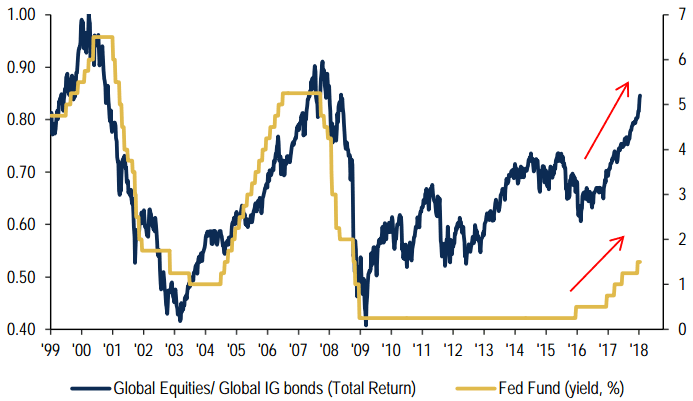Shilling has an interesting Gary Shilling piece on Bloomberg on impending recessions and stock market declines. With a great photo of a bear waving!
Follow the money. Find the profits!
 Liquidity is money. Regardless of where in the world that money originates, eventually it flows to and through Wall Street. So if you want to know the direction of the next big moves in stocks and bonds, just follow the money. Lee Adler's Liquidity Trader tracks and shows you the monetary forces that drive markets, like the daily real time Federal Withholding taxes shown in this chart. Follow the money. Find the profits! Try it for 90 days, risk free!
Liquidity is money. Regardless of where in the world that money originates, eventually it flows to and through Wall Street. So if you want to know the direction of the next big moves in stocks and bonds, just follow the money. Lee Adler's Liquidity Trader tracks and shows you the monetary forces that drive markets, like the daily real time Federal Withholding taxes shown in this chart. Follow the money. Find the profits! Try it for 90 days, risk free!
The recessionary indicators are numerous. Tighter monetary policy by the Federal Reserve that the central bank now worries it may have overdone. The near-inversion in the Treasury yield curve. The swoon in stocks at the end of last year. Weaker housing activity. Soft consumer spending. The tiny 20,000 increase in February payrolls, compared to the 223,000 monthly average gain last year. Then there are the effects of the deteriorating European economies and decelerating growth in China as well as President Donald Trump’s ongoing trade war with that country.
There is, of course, a small chance of a soft landing such as in the mid-1990s. At that time, the Fed ended its interest-rate hiking cycle and cut the federal funds rate with no ensuing recession. By my count, the other 12 times the central bank restricted credit in the post-World War II era, a recession resulted.
It’s also possible that the current economic softening is temporary, but a revival would bring more Fed restraint. Policy makers want higher rates in order to have significant room to cut in the next recession, and the current 2.25 percent to 2.50 percent range doesn’t give them much leeway. The Fed also dislikes investors’ zeal for riskier assets, from hedge funds to private equity and leveraged loans, to say nothing of that rankest of rank speculations, Bitcoin. With a resumption in economic growth, a tight credit-induced recession would be postponed until 2020.
“Recession” conjures up specters of 2007-2009, the most severe business downturn since the 1930s in which the S&P 500 Index plunged 57 percent from its peak to its trough. The Fed raised its target rate from 1 percent in June 2004 to 5.25 percent in June 2006, but the main event was the financial crisis spawned by the collapse in the vastly-inflated subprime mortgage market.
Similarly, the central bank increased its policy rate from 4.75 percent in June 1999 to 6.5 percent in May 2000. Still, the mild 2001 recession that followed was principally driven by the collapse in the late 1990s dot-com bubble that pushed the tech-laden Nasdaq Composite Index down by a whopping 78 percent.
The 1973-1975 recession, the second deepest since the 1930s, resulted from the collapse in the early 1970s inflation hedge buying of excess inventories. That deflated the S&P 500 by 48.2 percent. The federal funds rate hike from 9 percent in February 1974 to 13 percent in July of that year was a minor contributor.
The remaining eight post-World War II recessions were not the result of major financial or economic excesses, but just the normal late economic cycle business and investor overconfidence. The average drop in the S&P 500 was 21.2 percent.
At present, I don’t see any major economic or financial bubbles that are just begging to be pricked. The only possibilities are excess debt among U.S. nonfinancial corporations and the heavy borrowing in dollars by emerging-market economies in the face of a rising greenback. Housing never fully recovered from the subprime mortgage debacle. The financial sector is still deleveraging in the wake of the financial crisis. Consumer debt remains substantial but well off its 2008 peak in relation to household income.
Consequently, the recession I foresee will probably be accompanied by about an average drop in stock prices. The S&P 500 fell 19.6 percent from Oct. 3 to Dec. 24, but the recovery since has almost eliminated that loss. A normal recession-related decline of 21.2 percent – meeting the definition of a bear market – from that Oct. 3 top would take it to 2,305, down about 18 percent from Friday’s close, but not much below the Christmas Eve low of 2,351.
Now here is an interesting chart from BofAML showing global equity returns over global IG bonds and The Fed Funds rate. For the moment, Global Equities/Global IG bond (total returns) are rising with The Fed rate increases. Interesting.

BofAML’s chart does not support Shilling’s thesis. But it is because the BofAML chart focuses solely on The US Federal Reserve at a time where other major Central Banks are NOT tightening.

Join the conversation and have a little fun at Capitalstool.com. If you are a new visitor to the Stool, please register and join in! To post your observations and charts, and snide, but good-natured, comments, click here to register. Be sure to respond to the confirmation email which is sent instantly. If not in your inbox, check your spam filter.

